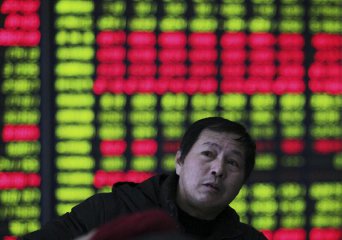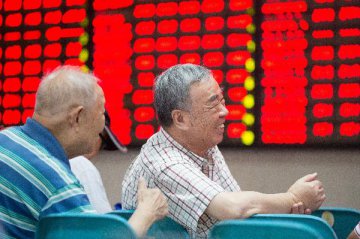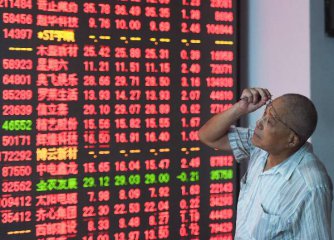
Stimulated by the more-than-expected Fed rates hikes in the future, pessimistic sentiment on China’s bond market escalated. Listed financial companies holding considerable amount bonds in the A-share market declined sharply, encumbering the stabilization and rebound of the mainboard. Analysts are in the view that the logic in the past was bond market adjustment can benefit the stock market, but in the context of tight monetary supply, the two markets share lots of commons. As the overall risk preference of the market is depressed, the stock market can hardly continue the uptrend. Though the A-share market has pulled through the most dangerous time and the panic sentiment has gradually waned, the market is still volatile and investors should not be involved in bargaining hunting. In the medium term, the recovery of China’s economy and time difference of adjustment may bring opportunities in the spring.
Momentum of A shares suppressed after sharp decline of bond and stock markets
Fed rate hike in December has not caused acute fluctuation on the A-share market in the first place, since it has long been expected. The A-share market soon rebounded after opened lower last Thursday and showed strength. However, the bond market and foreign exchange market declined sharply, which in turn ignited panic sentiment on the A-share market.
As to the bond market, yields climbed rapidly last Thursday, and Treasury futures fell to the daily limit for the first time since it was introduced to the market. On the currency market, U.S. Dollar Index hit 103, the highest level in 14 years. Central parity rate of yuan against the dollar exceeded 6.95, the new low in nearly eight years. Turmoil of the capital market, combined with the more-than-expected Fed rate hikes, further eased the risk preference in the A-share market. As a result, the A-share market overall declined last week. The SSE Composite Index and the ChiNext Index dropped by over 3.4 percent and 4.8 percent respectively. Of all the stocks, decline of 1,675 surpassed that of the SSE Composite Index during the week, accounting for 55 percent of the whole A-shares. But panic sentiment was not seen on the overall market. The shadow of market tumbling in the past has gone.
Of the 28 Shenwan primary industry indexes, only agricultural, forestry, animal husbandry and fishery industry rose slightly by 0.01 percent last week. Other sectors all have fallen back. Only commercial trade, chemical, national defense and military and building material sectors have declined by less than 2 percent; in comparison, architectural ornament, computer, nonferrous metals, banking and non-banking financial sectors have all dropped by more than 4.4 percent.
Last Friday, the bond market rebounded and market sentiment stabilized. The A-share market also saw capital inflow. Statistics from Wind show that though capitals flew out of non-ferrous, non-banking, banking, military sectors, seven Shenwan primary industries say capital inflow, in which food& beverage, real estate, architectural ornament sectors ranked among the top, attracting 230 million yuan, 103 million yuan and 99,678,100 yuan respectively; net purchases in pharmaceutical, biology, agricultural, forestry, animal husbandry, fishery, leisure service sectors all exceeded 65 million yuan.
But this might be simply technical rebound after sharp fluctuation, and weighted stocks still face huge pressure. Seen from the overall market, the SSE Composite Index though have stopped decline, the trading volume has shrunk significantly. Actually, in the context of foreign exchange market fluctuation and tight money supply, the stock market also cannot continue the uptrend. Founder Securities pointed out that the bond market recently faced not only weak liquidity due to the central bank’s policy to recoup short-term liquidity and release long-term liquidity, but also fragile sentiment. Rumor that the central bank will recoup entrusted outsourcing funds send the market lower. In the near term, the fragile sentiment and influence from tight money supply is unlikely to ease. Sinolink Securities holds that the market as a whole will stop decline, but the short-term shorting force will stay, and rebound will delay. Haitong Securities is in the view that the market will undergo adjustment due to tight regulation on insurance investment and tight short-term money supply.
Market still volatile, spring surge expected
When will the bond and stock market decline stop? Money supply is tight at the year-end, and medium and long term monetary policy constraints also emerged. The market in the near term can hardly stop fluctuation. But the economic recovery is still the most solid foundation for the market. In the future, economic stabilization and the accompanying opportunities may help the stock market get out of fluctuation, but it might wait till the spring of 2017.
Founder Securities believes that medium term policy has turned to curb bubbles and prevent risks. The policy direction of deleveraging and stabilizing foreign exchange will not change temporarily, and the continuous adjustment of the bond market has not yet ended. China’s economic stabilization in 2016 is expected to beat expectation, and the inflation expectation will also rise. The bond market will seek for new pivot. In 2017, we should pay attention to trading opportunities brought by inflation expectation and decline of real estate market.
GF Securities also indicates that after the recent market adjustment, the market is likely to surge in next spring. Considering the strong “macro adjustment” characteristics of the market since December, such as accelerated IPOs, financial deleveraging, and restrictions on insurance companies acquisitions on secondary market, once the adjustment is excessive, some new revising policies will be launched. This will form new forces to lift the market up. Therefore, after the recent market adjustment, a spring surge is expected.
In addition, Chen Wenhui, vice chairman of the China Insurance Regulatory Commission (CIRC), revealed the proposed regulatory rules to the media: insurance institutions shall not work together with parties acting in concert which are not insurance institutions, to acquire listed companies; insurance companies’ additional capital for investment in major stocks should be self-owned funds, instead of insurance funds; major stock investment shall be filed with the CIRC, and listed companies’ acquisition should obtain prior approval from the CIRC; the proportion of equity assets in the total assets of insurance company shall be reduced from 40 percent to 30 percent, and investment in a single stock is reduced from 10 percent to 5 percent of the total assets of an insurance company.
Though stricter regulation restricts insurance funds’ investment in the stock market and curbs insurance funds’ acquisition in the secondary market, Haitong Securities’ estimation shows that equity assets of insurance funds account for just 14 percent of their total assets, well below the 30 percent limit; under the pressure of narrowing assets and liability interest spreads, to increase allocation in equity assets is a general trend; since 2010, insurance funds’ annualized investment return from the stock market is 7.1 percent. Insurance funds are in favor of large capitalization, low valuation and high profitability blue-chip financial and real estate stocks.
Wait for opportunities patiently and make asset allocation in stock market cautiously
Though the most dangerous time has gone, the alert still cannot remove. Analysts suggested that before the market stand above the 10-day moving average, investors should be cautious in buying in. At the closing sessions, capitals were in favor of consumption and SOEs reform themed stocks. At the closing of last Friday, Midea Group Co., Ltd. (000333.SZ), Huaan Securities Co., Ltd. (600909.SH), Suning Commerce Group Co., Ltd. (002024.SZ), China Petroleum & Chemical Corporation (600028.SH), Shenzhen Minkave Technology Co., Ltd. (300506.SZ) and Jiangsu Wuzhong Industrial Co., Ltd. (600200.SH) all saw net capital inflow of more than 40 billion yuan. While chemical, pharmaceutical, biology, real estate, home appliance and communication sectors saw net capital outflow beyond 60 billion yuan.
Haitong Securities pointed out that SOEs reform sees the most definite investment opportunities. The Political Bureau of the Central Committee of the CPC held a meeting on Dec. 9 to study the economic work in 2017. It is proposed to “move faster in advancing critical and fundamental reforms in areas like SOEs, fiscal levy, finance and social security, and give better play to the driving role of economic system reform”. The briefing held by the State-owned Assets Supervision and Administration Commission of the State Council (SASAC) on Dec. 9 reported the progress of SOEs reform. State Grid Corporation of China claimed that it will study on mixed-ownership. Media reported that Sinopec Corp. is considering getting its sales subsidiary listed in 2017. Events like the resumption of trading of China Enterprise Company Limited (600675.SH) are all boosting vitality in the market. The Central Economic Work Conference held on Dec. 14-16 made it explicit that “mixed-ownership reform is an important breakthrough of SOEs reform”.
Sinolink Securities, claimed that it is always rosy about leading enterprises engaged in white spirit, meat products, dairy products, gourmet powder and etc. It is also optimistic about the industrial benefit brought by milk powder registration system and universal two-child policy. The industry is expected to see turning point in 2017 and see profit in 2018. The institution will continue to pay attention to relevant food & beverage companies involved in SOEs reform.
Translated by Adam and Jennifer























Latest comments